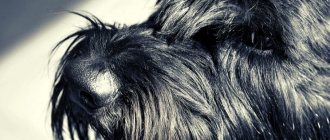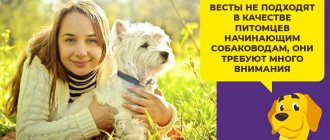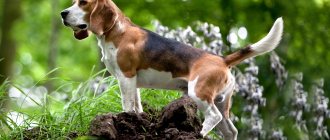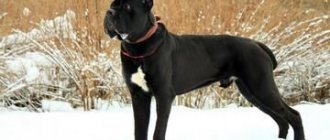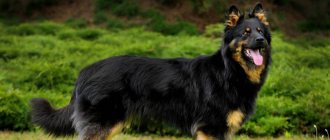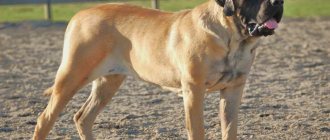Breed characteristics
| Short description | |
| Origin: | Germany |
| Conditions of detention: | Apartment, house with garden (room) |
| Purpose: | Guard, companion, decorative dog |
| Color: | Pepper and salt, black, |
| Wool length: | Long (trimmed and trimmed) |
| Adult dog size: | Height at the withers – 45-50 cm, weight – 14-20 kg |
| Average life expectancy: | 12-14 years old |
| Walk: | Walking twice a day is required |
| Physical activity needs: | High physical activity needs (1.5-2 hours of daily active walking or training) |
| Fédération Cynologique Internationale (FIC) classification: | Group 2: Pinschers and Schnauzers, Molossians, Mountain and Swiss Cattle Dogs; Section 1: Pinschers and Schnauzers |
| Puppy price: | 20000-50000 rubles. Without documents - up to 20,000 rubles, pet class - 20,000-28,000 rubles, breed class - up to 35,000 rubles, show class - 40,000-50,000 rubles |
History of the origin of the species
This breed is considered one of the fundamental ones for all dogs in Germany. It originated from wire-haired turf dogs; at the same time, the blood of Poodles, Wire-haired Terriers, Spitz, and Great Danes was mixed in.
In the period of the 17th-19th centuries it was called Pinscher for stables. Mittels were the first to be used by grooms to guard horses and catch small rodents in barns. The dogs became popular among the people as Rattlers (Rat – rat).
For the first time the pets proved themselves at the exhibition in 1979. And in 1980 the breed was renamed Schnauzer, which means bearded muzzle. In 1985 the first Pinscher and Schnauzer club was founded and the standard was approved. Mittel became the progenitor for his two growth varieties - Zwerg (small) and Risen (large).
Frequent problems and illnesses
Miniature Schnauzers are predisposed to the following diseases:
- hereditary hip dysplasia;
- cataract;
- epilepsy;
- pancreatitis;
- diabetes;
- oncology (melanoma, testicular tumor, benign lipoma);
- atopic dermatitis;
- unilateral cryptorchidism;
- hypothyroidism;
- bloating;
- infectious diseases of the genitourinary system.
Miniature Schnauzers are dogs with high intellectual abilities and excellent hunting and protective qualities. Many dog breeders believe that it is worth getting a pet of this breed once in order to unconditionally fall in love with their species. These cute bearded dogs love children, active games and are distinguished by their deep devotion to humans.
Siberian Husky is the hardiest dog breed
While greyhounds are the fastest dogs, huskies are the toughest. A husky team can travel more than 160 km per day, moving at a speed of more than 17 km/
Dogs' body temperature is higher than human body temperature
The average body temperature in dogs ranges from 38.3 to 39.4 °C. Higher body temperatures attract fleas and ticks, which is why dogs are more likely to be bitten by them than humans. ⠀
Dogs can memorize hundreds of words
The average dog is as trainable as a human child and can learn between 200 and 500 words. Moreover, the dog can learn the basics of mathematics, such as learning to count and order numbers in ascending order.
Distinctive features
There are three breeds that are recorded in the standards under different names, although they are practically no different in appearance. The miniature schnauzer reaches only 30-36 cm, Mittel - 45-50 cm, and Risen - 60-70 cm. All dogs have similar external features, smooth body lines and a wide bearded muzzle. The only main difference is the color of the coat. Medium and large Schnauzers can be black and pepper and salt in color, while dwarf Schnauzers can be white, black and silver.
- The head is long (half the length of the body), rectangular, with a flat skull and a prominent forehead.
- The muzzle is wide, square, shorter than the skull. Scissor bite (the upper jaw overlaps the lower jaw), a complete set of teeth. Lips are well pigmented black. Stop deep. The brow ridges are movable.
- The nose is wide with developed nostrils.
- The eyes are medium-sized, round, set high; the iris is dark.
- The ears are small, hang down on dense, hard cartilage, and are usually cropped at 2/3.
- The case is strong, rectangular in format. The back is straight with a wide loin and sloping croup. The withers are the highest point of the body. The belly is tucked in. The neck is thick and short. The chest is lowered to the middle of the knee, voluminous, but not wide.
- The tail is a continuation of the croup. When at rest it hangs down. It is customary to dock.
- The limbs are muscular, straight and parallel. The hindquarters are pulled back beyond the line of the croup. The paws are large, with hard, pointed toes.
- The coat is hard, long, has feathering on the face and limbs, and the undercoat is thick.
- Colors: black, pepper and salt.
Description of the breed
The characteristics of the breed describe Schnauzers as medium-sized dogs with coarse, hard hair and a strong build. Their dimensions range from 45 to 50 cm at the withers, and their weight varies from 12 to 20 kg.
The breed description is as follows:
- The head is elongated, the forehead is flat, the back of the head is not pronounced.
- The nose is smooth and wide. The transition from the nose to the frontal part is pronounced. Flat muscles are visible on the cheekbones.
- Lips black. The teeth are tightly adjacent to each other, even, the bite is correct. The eyes are oval, the eyelids are black and close-fitting. The ears are semi-erect, the bottom is supported by hard cartilage, the top is shaped like a triangle.
- The body is square. Muscles protrude on the chest. The neck is of medium size, the scruff is clearly visible. The back is strong, the loin is short.
- The stomach is tucked. The croup is slightly sloping, extending into the base of the tail and the thigh. The tail is shaped like a saber.
- The paws are strong. The forelimbs are straight, the shoulders are pronounced and well developed. The hind limbs have long tibiae and small femurs. The paws are round, the toes fit tightly to each other.
- The coat is hard, straight, and has no curls. The length is medium, the cover fits tightly to the body and becomes a little softer at the ends. There is an undercoat of medium length and high density. The brow ridges are well developed.
By and large, the breed has only two colors, but there is a wide variety of shades. Acceptable colors of the Miniature Schnauzer:
- black;
- pepper and salt - gray color, including a combination of white and black.
Puppies are allowed red or gray shades. The color of the coat evens out over time thanks to regular grooming.
White spots are not welcome among breeders, but sometimes they appear in the head or chest area.
Character
Miniature Schnauzers are playful and love to take part in active games. They are very loyal to their owners and try to please them in everything, making it easy to get in touch with them. However, sometimes dogs can be stubborn, so they require firm guidance. Dogs require a lot of attention from their owners, as they constantly require physical and intellectual stress. Active games should be combined with the training process to prevent your pet from getting bored. Schnauzers behave rather reservedly towards strangers, but a poorly socialized animal can show aggression. But dogs get along well with children if the child respects his boundaries and does not approach his food or resting place.
Miniature Schnauzers by nature have the character of hunters, so their instincts are still preserved. Because of this, dogs have a complex relationship with smaller animals such as cats or rodents. If they can still behave calmly with the former, then their natural instincts do not allow them to get along with the latter.
Schnauzers behave quite friendly with their relatives. However, if the dog belongs to the dominant breeds, the animals may have a conflict of interests. Moreover, even despite their average size, Schnauzers can fight opponents that are much larger than them in physique. The same trend can be seen in the behavior of puppies. Dogs take root well in families where they love active recreation. They enthusiastically take part in games, long walks and even family hikes. At the same time, pets do not tolerate loneliness well and quickly begin to get bored without their owner.
Photo of an adult dog
Photos of puppies
Features of character and behavior
This is a typical representative of working dogs, accustomed to working as a guard. They are designed to work with people and retain their functional abilities. Animals are soft, but loyal and true friends. They become very attached to their owners and do not like to be left alone for a long time.
Dogs are active, they need training and walking, so Schnauzers are not suitable for homebodies and busy people. They are smart and developed enough for narrowly focused training, but they are also stubborn.
Read articles about related breeds of the Miniature Schnauzer: “Hardy and smart - Giant Schnauzer” and “Brave guard - Miniature Schnauzer”.
Advantages
The main advantages of the breed include:
- Devotion, attachment to only one owner and family (a pet cannot get used to other owners, even with long-term cohabitation);
- Pronounced protective instinct (Schnauzers are born guards);
- Mittel feels the mood of those around him, does not impose himself, fits into the rhythm of life of any person;
- Observation, alertness;
- Affectionateness, love (especially towards children);
- Good memory, developed intelligence, quick learner;
- Activity, playfulness;
- Restraint, absence of random bursts of aggression.
Flaws
Character flaws appear for each individual separately. After all, temperament, although given from birth, is adjusted by upbringing and living conditions. One way or another, all Mittels are characterized by features that owners do not like:
- Dislike for fellow dogs (it is important to properly socialize the pet, accustom it to the equality of all dogs, otherwise the Schnauzer will try to show leadership at every opportunity);
- Grudge;
- Wary of strangers;
- Loud barking;
- Willfulness and stubbornness.
Character of the Miniature Schnauzer
The Miniature Schnauzer is suitable for active and self-confident people. For those who only need a dog for show, it is better to abandon this breed. Mittel cannot be pushed to the margins of life and left there forever; he requires constant attention and communication. At the same time, the dog calmly endures forced loneliness if it knows that it will still wait for its loved one, who will definitely give it maximum attention.
The character of this breed often shows stubbornness; for this reason, the owner of the dog should be a firm and experienced person.
The animal's hunting instinct does not allow it to find a common language with representatives of the cat family.
For a dog, this is primarily prey. The mittel will only get along with the cat with which it grew up. The pet will treat any rodent that the owner decides to place nearby as prey.
Males are characterized by aggressive behavior. To avoid this, your pet needs to be socialized from an early age.
There is an opinion that the Miniature Schnauzer has an excellent memory. You shouldn’t offend your dog, he will definitely remember this someday in the future.
A dog with excellent mental abilities quickly gets tired of monotonous and frequently repeated activities.
But she will take a variety of events and new physical exercises with pleasure. The pet will play any game with great zeal, entertaining both itself and its owner. Routine is not for Miniature Schnauzers.
Photo: https://pixabay.com/photos/schnauzer-dog-pet-animals-dogs-4154141/ The breed is very smart, even cunning.
Dogs use these qualities without a twinge of conscience in communicating with other four-legged animals, and with humans too. Therefore, you should prepare for the fact that in your life you will have to compare your intelligence and ingenuity with your own dog more than once.
An animal develops intellectually throughout its life. This is why communication between owner and pet is so important.
The Schnauzer dog has a pronounced desire for leadership. Throughout her life, she will test her owner’s “strength,” and if at least once she finds a weakness or crack, she will try with redoubled effort, trying to nominate herself for the leading position. You shouldn’t give in to a dog, even in small things.
Mittel is an optimistic person; he takes everything from life, enjoying every moment of it. But he should enjoy any activity. If a dog is not interested in something, it can become deaf right in front of its owner or pretend to be sick and weak.
Representatives of the breed have a lightning-fast reaction. They can get involved in any business so quickly that the owner does not even have time to blink an eye.
Attitude towards the owner
The Miniature Schnauzer becomes quite attached to family members and its owner. He will doze on his own bed only when no one is home, but the rest of the time he will follow his loved ones as a shadow.
Obsessiveness is not typical for a dog.
It is simply important for her to be close to family members and her beloved owner.
The dog’s love will not have to be won; it will be given to the person right away. But authority will have to be asserted.
Miniature Schnauzers love to express their affection very vigorously. Moreover, they do this at any moment, even when no one is waiting for her.
Photo: https://pixabay.com/photos/dog-canine-schnauzer-puppy-pet-1350934/
It is also worth preparing for the fact that stubborn and cunning dogs will try to achieve concessions in everything from the first days. Having conceded only once, you will have to concede constantly; the animal does not give back the conquered territories. If you let your pet lie next to you on the sofa, you shouldn’t be surprised if the next morning you wake up in the same bed with him.
Attitude towards children
The Mittels easily find a common language with children. Perhaps this is love, but most likely the dog is simply protective of the baby, knowing that children are one step lower than her and must be protected and protected. The animal loves to play with children, forgiving them of minor mischief.
The Miniature Schnauzer will not allow his person to be disrespected and will not tolerate bullying.
Therefore, children need to be taught to treat their four-legged friend correctly and not to violate the boundaries set by the dog, especially in those moments when it is eating or resting.
Attitude towards strangers
The Schnauzer dog breed is very suspicious of strangers. Even guests whom she sees for the first time make the dog wary. Until the mittel is convinced that strangers come with good intentions and are accepted into the family, he will not let his guard down. And the dog will not allow visitors who for some reason cause a surge of negative feelings in the owner.
The Miniature Schnauzer is an excellent watchman and guard for his family.
Care and maintenance
Schnauzers are kept indoors; Mittels fit freely in a city apartment. Free walking is allowed in the local area at average air temperatures. Animals need regular walks and certain cosmetic procedures.
Before buying a puppy, places for food, temporary toilet and sleeping are equipped. The dog will need bowls on stands, a comfortable bed that protects from drafts, combs, toys, a leash and a collar. It is also important to provide your pet with vitamins and quality nutrition.
Nutrition
The breed is characterized by a weak digestive tract and allergic disorders. Therefore, the choice of food for her will become the basis of health. You should consult with the breeder, purchase food that has already been used or choose a similar one. If any negative reactions occur, the menu is compiled anew.
Owners can feed their pets natural or prepared foods. The second option is convenient because the granules do not need to be prepared, they are convenient to use, store and transport. Dry food contains a complex of all necessary microelements. But low-quality cheap products greatly harm animals.
Miniature schnauzers will benefit from super-premium dietary lines of food with low grain content for active medium-sized dogs.
Natural nutrition is healthy, but not always comprehensive. The owner himself selects the products from which he makes up the diet, which takes more time. The daily menu should consist of 30-50% proteins (turkey, rabbit, lamb, eggs, cottage cheese and kefir). The rest of the serving is carbohydrates (rice, buckwheat, oatmeal, boiled or fresh vegetables and fruits).
It is forbidden to feed dogs human food: spicy, fried, fatty, spicy, salty, sweet, flour. The diet should not contain legumes, butter, pork, baked goods, millet, sugar, citrus fruits, or bones.
At 2-3 months , when complementary foods are introduced, puppies are given food 5-6 times a day, a teaspoon. This can be milk and low-fat broths. At 4-5 months, pets are transferred to 4 meals a day, and by one year - to two meals a day. On average, the daily norm of a Miniature Schnauzer is 500-600 grams of food. The volume varies depending on the activity and weight of the dog.
We recommend that you read a detailed article on the topic: “How and what to feed a dog: types and characteristics of nutrition.”
Health
Animals live 12-15 years and have good immunity. They are hardy and strong, but do not tolerate heat or cold well. During the formation of the breed, diseases developed that are now inherent in almost all individuals. Owners need to monitor the appearance of inflammatory processes in the ears and mucous membranes of the eyes, irritation of the dermis, and follow the vaccination schedule.
Vaccinations
All pets need vaccination against dangerous viral diseases. This is the best preventative measure; otherwise, the risk of infection always exists. Even decorative pets that do not go outside and do not come into contact with other animals can contract the infection. A person carries millions of bacteria on himself, especially on his shoes.
In veterinary medicine, it is customary to give 2 vaccinations, although in fact, you can vaccinate a puppy against almost all infectious diseases. The laws of the Russian Federation state that owners are responsible for their dogs. Pets cannot be transported across the border without basic injections.
At 2 months , after deworming, pets are injected with the following strains:
- plague;
- leptospirosis;
- parvovirus enteritis;
- flu;
- hepatitis A.
The procedure is repeated after 2 weeks , at 6 and 12 months , and then annually . Upon reaching 7 months , the puppy is diagnosed with a strain of rabies (repeat annually or once every 2 years).
It is important to follow several rules:
- Vaccination at home can only be carried out by experienced dog breeders with full confidence in the puppy’s immunity and the absence of allergies;
- Devices must be sterile;
- 2 weeks before the procedure, the pet is cleaned of helminths and fleas;
- On the day of vaccination, the animal’s temperature is measured; if it deviates from the norm, vaccination is not carried out;
- Weak, sick pets and pregnant females are not allowed for vaccination.
Important article on the topic: “Everything you need to know about dog vaccinations.”
Diseases
During constant breeding work, Mittelschnauzers acquired hereditary diseases:
- Allergic dermatitis and disorders (food or chemical);
- Skin problems (irritation, rashes);
- Epilepsy (fits and convulsions appear at 5-6 years);
- Hypothyroidism (thyroid deficiency);
- Diabetes;
- Hip dysplasia (expressed as severe pain and lameness);
- Difficulties in the digestive process;
- Cataract.
In addition to genetic diseases, dogs can become infected with viruses or catch colds.
Walk
Walk the dogs 2 times a day for 1-1.5 hours . Puppies begin to be taken outside 14 days after the second vaccination. First, the babies are carried out in their arms and accustomed to the company of other people and pets. Then a leash or harness is put on the animal. You can only let him go when Mittel is used to the nickname and responds to it. Up to 3-4 months, pets are walked 3-4 times for 30 minutes each, and then transferred to a standard walk.
Despite their small size, Schnauzers need serious exercise. Suitable dog sports: freestyle, agility. You can take your pet for a run or actively play with it (balls, discs, tug-of-war).
Grooming
The peculiarity of the coat requires individual care measures. The fact is that Miniature Schnauzers have hard hair, they do not shed, so the hairs simply die off and remain on the body. Therefore, every 3-4 months the dog is plucked (trimmed). The procedure requires special skill and technique, so it is better to contact specialists. The bangs and beard must be trimmed. Brush the undercoat 3 times a week with a long-toothed brush.
Another cosmetic procedure is ear cropping. In some countries it is prohibited, so animals with untrimmed shells are also accepted at exhibitions. The operation is performed on puppies no older than 3 months so that the edges heal evenly and without scars.
Dogs are bathed no more than twice a year (preferably in warm weather), but the beard and paws are washed daily. Ears are examined every day and cleaned as needed. Teeth are cleaned of plaque once a week. It is important to monitor the process of eye suppuration. If there is heavy yellow discharge, you should contact your veterinarian. Nails are trimmed every 2-3 weeks if they do not wear down on the asphalt.
Treatment for helminths and fleas is carried out once every 3 months. In case of heavy helminthic infestation, a course of treatment is prescribed by a doctor.
Pros and cons of the breed
| pros | Minuses |
| The breed is practically not prone to shedding | Doesn't get along well with other animals, especially rodents and cats |
| They have good security qualities | Requires frequent physical activity |
| Well developed guard qualities | Difficulties may arise when caring for the coat |
| Good with small children | Suitable for experienced owners only |
| Trainable, but needs a firm hand | |
| Allowed to live in a city apartment | |
| Enjoy doing agility |
Mating
Experienced breeders try to breed dogs in late summer or early autumn so that puppies are born in the autumn-winter period. It is believed that this way the dogs will be stronger and more resilient. They begin to breed animals after full puberty (at 20-25 months). At this time, the female begins her third heat. Favorable days are 13-15 from the beginning of the cycle.
Experienced girls themselves know when to let a dog in. The owner needs to watch for signs. When the discharge becomes lighter and the loop loosens, ovulation begins. Even after mating, the owner must record the duration of pregnancy or pause (if mating did not take place).
A few days before the heat, the female is registered at the club in order to find an advantageous match (the male complements the female’s shortcomings and vice versa). Owners fill out paperwork, set a meeting date, and set a specific price.
The animals are brought together in a spacious neutral territory (or at the male’s house). They are given time to get to know each other. It is best to walk the dogs together in advance. When the girl is ready and the boy is ready, the owners should help the pets sit comfortably and steadily. The females are held under the belly, and the males are directed into the loop. Repeat knitting every other day.
The first signs of pregnancy appear after a couple of weeks. The dog becomes restless, goes to the toilet more often, and asks for more food.
Specialists will be able to confirm the status only in 3-4 weeks using an ultrasound or test. At this time, it is important to avoid false pregnancy and not confuse the fetus with peometra (inflammation of the fallopian tubes).
Read a detailed article on the topic: “Everything you need to know about breeding dogs: appropriate age, what to do if it doesn’t work out, rules and tips.”
Key points in training
For service dogs, special training sets are selected, but if the pet is needed solely as a companion, then a basic course will be enough for it. From the very first days of being in a new home, the puppy is taught the rules of behavior. He is not allowed to snap, bite members of the household, or sleep in his owner’s bed.
The dog needs to remember its name. To make the learning process easier and faster, the nickname chosen is simple and ringing. During everyday situations and training, the puppy is called only as its nickname sounds.
Training should take place under the guidance of an experienced dog handler, because Mittels are stubborn . First of all, the puppy learns to walk in noisy places, suppresses fear, aggression and other negative emotions. The “Dog in the City” program is mandatory for all city pets. It will promote proper interaction between the dog and the owner and teach basic commands (“place”, “sit”, “no”, “near”).
Read about how to properly train a dog in the article: “Training a puppy: effective methods from dog handlers, learning commands at home.”
A method of motivation and encouragement should be used. Mittels do not like harsh measures, they remember the offenders and seek revenge.
History of appearance
The history of the origin of the Miniature Schnauzer is not known with certainty. However, there is information that this is a very ancient breed, the ancestors of which are turf dogs that lived before our era.
Germany is considered to be the homeland of the mittels.
Many artists depicted small dogs in their canvases, completely similar in appearance to modern miniature schnauzers. The paintings date from the 15th to 17th centuries.
There is still debate about which breeds were directly involved in the creation of the Schnauzer. Some suggest that a German poodle, a wire-haired pinscher and a Wolfspitz were present here. Others argue that bulldogs and terriers, griffons and pugs contributed to the creation of the breed.
Be that as it may, initially the Mittels lived in the stables, taking an active part in ridding the owner’s property of small rodents. They were taken with them as companions when going on walks and on errands. People quickly appreciated their intelligence, loyalty and watchdog qualities. But they were in no hurry to separate the dogs into a separate breed, calling them “stable pinschers.”
At the exhibition in 1879, the miniature schnauzer not only took an active part, but also managed to win.
This event brought attention to the dog, even though the participant was presented as a wire-haired pinscher.
The breed standard was developed by 1880. At the beginning of the 20th century, the breed came to the States, where the dogs were initially classified as pinschers and only in the mid-40s were transferred to the working group.
In Russia, targeted breeding of mittels began only in the second half of the 20th century.
How to choose a puppy
Choosing a puppy always involves answering the questions: what gender, what age, appearance, expected character, class. Having decided, the owner will be able to explain to the breeder what he needs and for what purposes.
Gender often determines character. Boys are tougher, physically stronger, more competitive, they are suitable for service and protective functions. Girls are more obedient and softer, making ideal companions. Temperament is also hereditary. Therefore, it is important to get to know the puppies' parents. This will help you understand what the kids will look like and how they will behave.
Education plays a huge role in the development of character. Genetic predispositions can always be overcome by manners and rules of behavior.
You can take babies away from their mother after the first feeding (at about 1.5-2 months). This age is considered favorable for a change of environment, acquiring first skills, and getting used to new owners. Such a dog will have to be looked after a lot, monitored nutrition, given bait and vitamins, and vaccinated. You can buy an already matured pet (at 5-7 months). Then its working and external characteristics will be obvious. But raising an adult dog is much more difficult.
There are 3 classes into which purebred animals are divided:
- Pet class – awarded to puppies with deviations from the standard, which does not prevent them from remaining good pets;
- Breeding class – dogs for breeding (with ideal external characteristics);
- Show class – animals with good pedigree, parents are champions (suitable for a show career).
Depending on the type, the price is set. Small puppies do not receive a grade, but the breeder makes an assumption regarding the dog's future and his career.
It is recommended to buy Mittels only in official nurseries. Breeders will present all documents and give recommendations on keeping the pet. Some clubs reserve the right to decide whether the owner is suitable for the baby, and to refuse if the buyer does not meet any criteria.
Puppies must be healthy, cheerful and clean. The average cost of Miniature Schnauzers is 20,000-50,000 rubles.
Education and training
For such a mistrustful and cautious breed as the Miniature Schnauzer, raising a puppy is a process of building mutual trust between dog and owner. Considering the time it takes to get used to new living conditions, the puppy will not immediately trust the owner, despite the absolute obedience characteristic of the breed.
Oddly enough, toilet training while walking can sometimes be more difficult than it seems. Awareness comes only after a certain time has passed, which is necessary for the puppy to adapt.
Having stoically passed the difficult period, the Miniature Schnauzer begins to readily accept new commands, regarding them as an act of another game. Early socialization greatly helps the adaptation process, and a large number of people, for example, park walks in a crowd of strangers, teach the dog not to be afraid of public places. In the future, this will be very useful if exhibitions or agility work are planned.
The main feature of the breed is considered to be the instant assimilation of commands and reckless obedience to them. Dog handlers claim that by the age of three months, bearded dogs are able to learn at least twenty commands.
Training with a professional dog handler begins when the dog reaches 5-6 months of age, and before that they raise the puppy on their own.
For the temperamental Schnauzer breed, training is a series of games that inflame the dog's excitement. The Mittels are inclined towards education and enjoy working on site.
Their endurance and tirelessness are sometimes amazing, but overwork is also unacceptable with all the pet’s irrepressible energy, since the dog can independently practice a failed element of training until the trick fails or until the dog falls in exhaustion.
Kennels where you can buy a puppy
You need to choose a nursery based on reviews from previous clients and awards given to the students. There are several official clubs in Russia that have proven themselves well among dog breeders:
- “NiM” St. Petersburg – https://nim-schnauzer3.narod.ru/;
- “Rus Rastr” Moscow – https://www.rus-rastr.com/;
- “Nettle Great” Nizhny Novgorod – https://nettlgreitkennel.jimdo.com/;
- "Alpen Travel" St. Petersburg - https://at812.narod.ru/Index.htm;
- “From Barbatsutsy” Moscow – https://otbarbatsutsy.ru/ru/mittelshnaucer.html;
- “Feble” Nizhny Novgorod – https://www.schnauzer-nnov.ru/?page_id=10.
The Miniature Schnauzer, like its closest relatives, is an ideal companion and assistant in all household matters. It will entertain the children, lift their spirits, and protect the house. But in order to receive boundless devotion and love, it must be given to the dog in the same amount.
